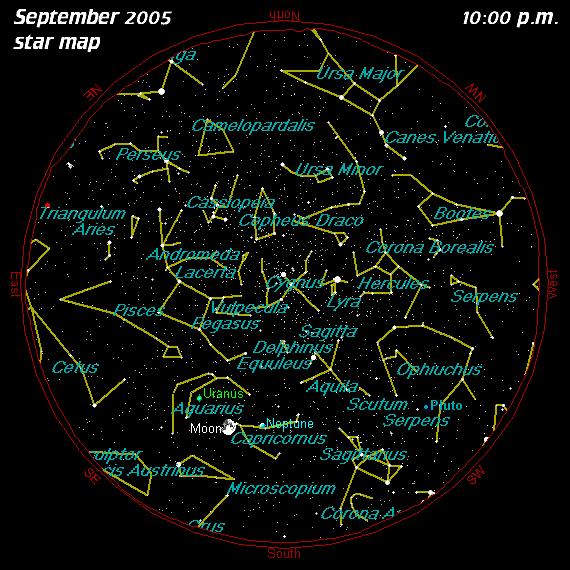



![[Moon Phases]](../moonphases/2005-09-phases.jpg) |
|---|
![]()
![[Venus-Jupiter Conjunction]](9-01-05-ven-jup-conj.jpg) |
|---|
| Venus (lower) and Jupiter brighten up a Coopersburg, PA neighborhood just prior to the Labor Day weekend. September 1 digital photo by Gary A. Becker... |
![[Venus-Jupiter Conjunction]](9-06-05-vjmoon-conj1.jpg) |
|---|
| Venus (upper left) and Jupiter are joined by a three day old waxing crescent moon on the evening of September 6. Digital photo by Gary A. Becker... |
![[Courthouse Wash, Arches National Park]](9-05-courthouse-arches.jpg) |
|---|
| If skies like these are to be preserved, US citizens will have to become advocates of the night. Photography of Courthouse Wash in Arches National Park, near Moab, Utah by National Park Service Night Sky Team member Dan Duriscoe and wife Cindy Duriscoe... Read above! |
![[Bryce Canyon Milky Way]](9-05-bryce-milky-way.jpg) |
|---|
| The Milky Way shines brightly from Bryce Canyon in southwestern Utah, rated by the Night Sky Team as the third darkest national park in the United States. Photo by Gary A. Becker... |
![[Black Forest Star Party]](9-05-black-forest.jpg) |
|---|
| Black Forest Star Party 2005: Photography by Gary A. Becker, lower right inset with the help of Adam R. Jones (right)... |
![[Black Forest Milky Way]](9-05-black-forest-milky-way.jpg) |
|---|
| From Cherry Springs State Park in north central Pennsylvania, the summer Milky Way stretches across the sky from horizon to horizon with only minor amounts of light pollution visible. Thanks to Lynn Krizan of Kutztown University for the use of his equatorially aligned telescope to which I piggybacked my camera for this five minute exposure. Gary A. Becker photography... |
![[Black Forest Observer]](9-05-black-forest-observing.jpg) |
|---|
| Many observers watch the heavens all night at the Black Forest Star Party, taking advantage of the exceptionally dark unpolluted eastern skies. Gary A. Becker photography... |
![[Perseus, Andromeda, and Cassiopeia]](9-05-perseus.gif) |
|---|
 |
